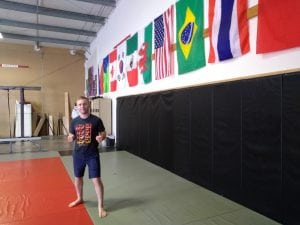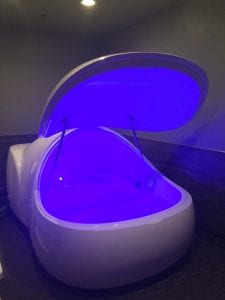Imagine you’re climbing into a round, illuminated pod filled with water. You put in earplugs to keep the water out, lie down and close the overhead door. The water – extremely buoyant due to 1,200 pounds of Epsom salt – lets you float with ease. As you relax, the light inside the pod dims to darkness. In this soundless void, the water equalizes to your skin temperature and you feel like you’re floating in space, free of tension, surrounded by nothing.

This is the experience of float therapy, a mentally and physically therapeutic activity offered by Bellingham-based Still Life Massage and Float. For Hunter Clagett, a competitive MMA fighter and co-owner of Bellingham Mixed Martials Arts, floating has helped soothe both his muscles and his mind.
“It feels like infinite space to me,” Clagett says of the float therapy sessions, which he currently does every other month. After an hour inside a float pod, Clagett feels calm, peaceful and very relaxed.
“Physically, it allows your body to completely relax in a way you can’t, even when you’re lying in bed,” he says. “It’s like you just took the best nap of your life, even though you didn’t sleep.”
From Within

Clagett’s interest in martial arts began when he took a kickboxing class at Western Washington University in 2003. He fell in love with it, eventually moving on to Chinese and Filipino martial arts. He began training with the founders of Bellingham MMA, the gym he now co-owns with his wife, in 2005.
In 2007, Clagett began fighting competitively. His first bout didn’t go as planned. In front of a literal vanload of friends, family and martial arts students, he was knocked out by his opponent after just 14 seconds.
“So much was riding on this in my head,” Clagett recalls. “My coach had just gotten done telling me, ‘Hey, you’ve got five minutes; don’t rush. Take your time.’ So, I rushed right in and got knee’d in the face.”
After the KO, his coach found Clagett a silver lining: in his first fight, he’d been knocked out in 13 seconds. The lesson Clagett learned was important: have the right mindset. And now, after more than 30 professional fights, he’s tried just about every mindset, from putting tons of pressure on himself to simply letting go of a fight’s outcome.
“When you start putting that pressure on yourself, you don’t have fun,” he says.

Today, Clagett practices everything from Muay Thai kickboxing to Brazilian jiu-jitsu to Western-style wrestling. As a competitor, he does his fair share of conditioning work, including swimming, running, calisthenics and lifting. As he’s gotten older, he feels the toll on his body more. That’s why he focuses as hard on recovery as he does on actual workouts. He finds floating – in addition to yoga and massage – helps quite a bit.
From a physical perspective, Floating’s athletic benefit is similar to a traditional Eposom salt bath: easing sore muscles and joints. But Clagett is also interested in the experience’s mental benefit which, for him, acts as a shortcut to meditation. Often too distracted to meditate at home, the float tank allows him to be totally alone with his thoughts. Those thoughts come and go, and Clagett says he tries not to silence them.
“I think it’s very common that, instead of thinking about things that are difficult, instead of confronting things that are on our mind or that are weighing us down, we distract ourselves,” he says. “We pull out our phones. This is an opportunity to stop and do nothing but confront your feelings and your thoughts. To not fight those emotions, to not push back against them but to accept them and let them pass by.”

He’s noticed this ability lacking in many competitors.
“I’ve known a lot of athletes who – if they can just do what they do every day in the gym when they go to compete, they’ll be fine,” he says. “The problem is that they don’t often translate that very well even though, in reality, it’s exactly the same thing.”
For Clagett, Floating helps him process the anger and frustration associated with a losing fight, helping him confront his ego and find acceptance. This, in turn, makes him a more focused fighter who enjoys each bout.
“No one ever gets out of this thing without experiencing failure,” he says. “Confronting that, and accepting it, is part of the process.”
Give It a Shot

Clagett highly recommends floating to his students and to other athletes. Although he notes that sensory deprivation might be intimidating to someone with claustrophobia, he says it seems to greatly benefit most people. For anyone who’s a little nervous, Clagett points out that the pods don’t lock and lights can be turned on at any time.
After a float experience, participants shower off the solution and are encouraged to relax with tea in comfortable chairs, keeping the Zen going before they head back into the hustle of daily routines. Float sessions begin at $65 per hour, but those with monthly float memberships can float once a month for $55, twice for $100 and four times for $180.
For additional pricing and floating information, visit the Still Life Massage and Float website.
Sponsored








































